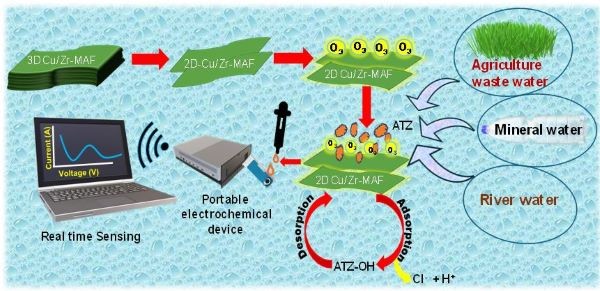Professor Ha Tae-Jun‘s Research Team Develops a Cu/Zr Metal Azolate Framework
- admin
- 2024-12-26
- 1664
· Professor Ha Tae-Jun‘s Research Team (Department of Electronic Materials Engineering) Develops a Cu/Zr Metal Azolate Framework-Based High-Performance Electrochemical Biosensor for Ultra-Low (~zM) Atrazine Detection
Views 13 | Created 2024.12.17 | Modified
2024.12.17 | Public Relations Team
·
Professor Ha Tae-Jun‘s Research Team (Department of Electronic Materials
Engineering) Develops
A Cu/Zr Metal Azolate Framework-Based
High-Performance Electrochemical Biosensor for Ultra-Low (~zM) Atrazine
Detection
- Published in the renowned international journal Analytica Chimica
Acta (IF: 5.7, top 9.9% in JCR ranking) -

Professor Ha Tae-jun‘s research team (Department of Electronic
Materials Engineering) successfully developed a high-performance
electrochemical biosensor for monitoring pesticide residue atrazine. The team
fabricated a three-dimensional metal azolate framework (MAF) using a Cu/Zr
heterometallic combination and optimized it through surface modification and
ultrasonic treatment to create a two-dimensional MAF structure. The results of
this study were published in Analytica Chimica Acta (IF: 5.7, top 9.9% in JCR
ranking), a leading international journal in analytical chemistry by Elsevier,
under the title, "Post-synthesis surface modification of Cu/Zr metal
azolate framework: A pathway to highly sensitive electrochemical biosensors for
atrazine detection." (Reference:
https://doi.org/10.1016/j.aca.2024.343547)

With the rising demand for food, agricultural
contamination from pesticides and water pollution have become significant
social issues. As a result, there is growing interest in developing
electrochemical-based high-performance biosensors for monitoring, offering
rapid response, high sensitivity, and selectivity for pesticide detection. MAF,
similar to metal-organic frameworks (MOFs), features a highly porous structure
and is widely used in various applications related to gas adsorption,
catalysis, and storage. However, to develop high-performance biosensors capable
of detecting ultra-low concentration target substances, challenges such as
relatively low electrocatalytic activity and chemical stability must be
addressed. This requires prior research on the design and optimization of the
synthesis of sensing layer materials.
In response, Professor Ha Tae-jun's research
team (Department of Electronic Materials Engineering) developed an
electrochemical biosensor capable of detecting ultra-low concentrations of
atrazine. The team transformed a three-dimensional MAF into a two-dimensional
structure using a simple ultrasonic treatment method and enhanced sensitivity and
selectivity through surface modification. Two-dimensional MAFs have a larger
surface area per unit volume and enhanced interactions with molecules, making
them advantageous for applications in gas adsorption, catalysis, and sensing. Additionally,
their multilayer structure allows for the insertion of various substances or
ions between layers, significantly improving electrical conductivity and
catalytic performance. Using this approach, the research team successfully
demonstrated a high-performance biosensor with an exceptionally low detection
limit of 0.26 zM, a wide linear range from 1 zM to 1 M, and long-term chemical
stability, maintaining performance for up to 60 days under ambient conditions.
Meanwhile, this study was conducted solely by
Professor Ha Tae-jun's research team. Professor Ha Tae-jun has published over
80 papers related to advanced materials and process optimization for sensors
and energy devices and holds more than 20 patents. Additionally, Professor Ha
serves as the Industry-Academia Collaboration Director of the Korean Sensor
Society. Bhavna S. Hedau, a PhD candidate and first author, has demonstrated
exceptional research achievements, publishing results in top-tier international
journals, including ACS Nano and Carbon.